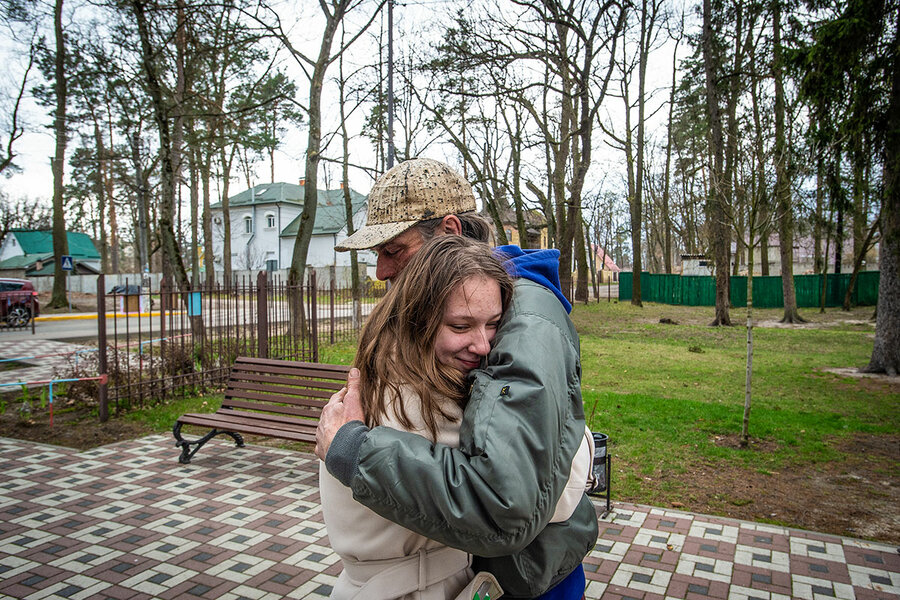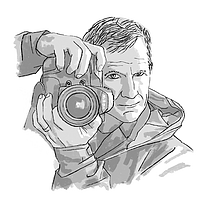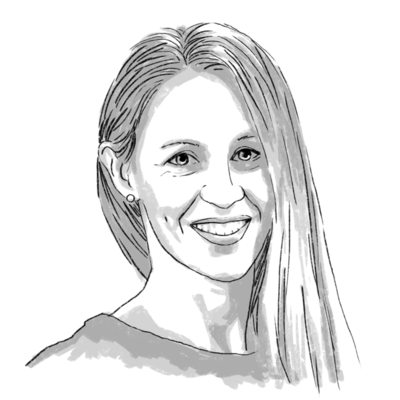Ukraine: Narrative of war’s atrocities is ‘forging a nation together’
| Bucha, Ukraine
The Ukrainian teacher appears haggard, exhausted, and overwhelmed by the trauma of witnessing Russia’s deadly military advance on his hometown of Bucha, the suburb northwest of Kyiv whose name has become synonymous with Russian cruelties in Ukraine.
As the Russian troops arrived, Oleh Azarov recalls, he helped wounded and retreating Ukrainian soldiers, even as he feared local infiltrators. Going outside was terrifying, he says, because “you never know how this will finish; people were being killed in the streets.”
“They were very intense days and nights. ... I stayed to see it with my own eyes,” Mr. Azarov says of the occupation of Bucha. Later, the gruesome scenes of bodies left in the open by withdrawing Russian forces – often with hands tied behind their backs and shot execution-style – reverberated around the world.
But Mr. Azarov was not alone in witnessing the atrocities as they occurred: A handful of his students also stayed in Bucha. Now, the teacher is planning how to harness those shared experiences in his classroom.
“I don’t know what I will be able to tell them, what I will be allowed to tell them, and what they can hear,” says Mr. Azarov. “I feel like some of my pupils saw even more than I saw.”
By chance, while speaking to this reporter in front of Bucha’s General Education School No. 1, Mr. Azarov sees one 10th grader for the first time since the war began.
They hug each other warmly, and Mr. Azarov wipes away tears, because Maryna Basyuk has survived.
“The first days we cry; then we tell our stories. ... Everyone is telling stories now,” says Mr. Azarov.
A physical education instructor, he also teaches a civil defense course once known by its Soviet-era title, Defending the Motherland. A year ago, its title became Defending Ukraine – and Mr. Azarov anticipates new interest in concepts like national pride and dignity.
“This situation,” he says, “is forging a nation together.”
Visceral shared experience
Indeed, the combined power of those individual stories is creating a new national narrative in Ukraine, of citizens discovering the will to resist against an overwhelming Russian military force, in a nation that gained independence in 1991 amid the breakup of the Soviet Union.
Russian President Vladimir Putin claims Ukraine “does not exist” on its own. Instead, he says, it’s part of a neo-imperial collection of Russian-speaking peoples called Russkiy Mir, or “Russian World,” that in Ukraine’s case must be “liberated” from Western enemies.
But Russia’s war is instead reframing and reinvigorating Ukraine’s own national identity, forged with the value of a visceral shared experience – traumatic though it has already been.
For Ukrainian educators, the challenge is how to teach that story in the future, how to integrate it into Ukraine’s national history as a watershed event that catalyzed a unity of purpose and strength of resolve.
Martin-Oleksandr Kisly, a historian at Kyiv Mohyla Academic University, says the magnitude of Russia’s invasion is prompting “a new grand historical narrative for Ukraine, because we still lack it.”
“Through all the period of independence we lacked that grand historical narrative, and now there is a possibility of securing it,” says Mr. Kisly, who is from Crimea and is considering an oral history project of the current war. “How we teach it in five years will be different from how we teach it in 10 years – it depends on how this war is finished.”
And, he says, who writes the history.
Varied experiences
Even establishing the record of events will be a challenge. Mr. Kisly is concerned about “re-traumatization” as Ukrainians recount their personal stories, which could affect his own oral history plans.
Every Ukrainian who stayed in Bucha – as well as citizens along front lines across the country – has stories of survival, bravery, fear, and resolve that now echo across the nation.
Ukrainians say the new national narrative, to be credible and relevant, will need to incorporate their varied experiences.
Those voices are evident along the Bucha roads where the Russian armored column was destroyed, where the charred hulks of Russian vehicles – and the bodies on sidewalks and street corners – have now been cleared away.
“I think we should listen to every witness, and collect all the information,” says Olena Viktorivna, a courier driver in her late 50s, who is walking where the ruins of Russian armor once lay.
She describes “bodies piling up” during the Russian occupation, and volunteers refusing to collect them because it was “too dangerous.” Neighbors – her house is around the corner – made holes in backyard fences to move around without stepping onto the street.
But Russia was not the only one responsible for destruction, she says. The Russian column was destroyed, Ms. Viktorivna notes, but it was Ukrainian airstrikes that destroyed it, wrecking civilian houses in the process.
The Ukrainian voices include those of the Goncharenko family, which finally could bury its patriarch, Mykola, last week. He was killed March 4 when Russian troops shot up and burned his car, says Ludmila, his wife, who survived the incident. The family could only identify the remains, weeks later, because a volunteer had written the license plate number on a tag.
Saying its final goodbye, this distraught family cries and carries red carnations, in a scene now all too common in Ukraine.
Those voices are evident, also, at the Bucha morgue, which continues to grapple daily with an overflow of bodies collected from across the region. Officials now say that toll tops 1,000 dead civilians.
“We are working day and night, 24/7,” says an overworked volunteer. He asks a visitor if they will suit up in protective gear to help.
His name? In a rush, he says, “It does not matter.”
“Only real facts will be taught”
In Borodianka, some 15 miles northwest of Bucha, Ukrainian Lt. Gen. Oleksandr Pavlyuk, commander of the Kyiv military region, describes the damage in the district to the Monitor.
“Everything is destroyed,” he says. “Now you can see Russkiy Mir.”
In this town, the front of the building seized by Russians as their military command center is painted with skulls and the letter V. The front yard is carved with sandbagged trenches.
Despite rain, residents inundate a nearby Orthodox church for clothing donations. A few doors down, at a school-turned-volunteer center, the prices of municipal coffins are taped to the door, along with the location of the prosecutor’s office inside: Room 46.
“This situation has united our country, our people, our nation,” says Lieutenant General Pavlyuk. “In 1991 we got our independence in a peaceful way, and now we are paying with our blood.”
In the future, he says, “Only real facts will be taught, and everybody sees a real situation, a real picture. We shouldn’t tell any fairy tales.”
In Bucha, Maryna, Mr. Azarov’s student, recounts how she spent most of the monthlong Russian occupation in a basement with three families. They cooked for each other with a wood stove, and hid a generator from the Russians that they used to draw water from a secret well.
Her older brother, Oleksandr, was a target of potshots when Russian troops first arrived. A neighbor’s apartment was wrecked.
And a Russian sniper was placed on the ninth floor of a nearby building, its lower floors lined with mines. Russian soldiers smashed the residents’ mobile phones, Maryna recounts, and warned people they would be killed if the sniper’s position was revealed.
“I had never been feeling myself a big patriot, but now I feel hatred for the Russians because no one did what the Russians did, and everyone should know about it,” says Maryna. After taking little notice which language she chose to speak, the lifelong Russian speaker now prefers Ukrainian.
“I am much more aware that I am Ukrainian,” says Maryna. “I feel like I grew up a lot in this time.”
Changed syllabus
Such sentiment means Mr. Azarov expects a “dramatic increase of interest” among students in his civil defense course. Defending Ukraine still uses Soviet-era books, and emphasizes how to pack an emergency bag and first-aid techniques as well as coping with chemical warfare and handling assault rifles.
But there is also an ideological component – which in the past made students’ eyes roll – that is likely to elicit renewed interest in national pride.
“A main goal is to understand why we learn this, and why you would need to love and defend your country,” says Mr. Azarov. “I am sure it will change a lot.”
Maryna is already converted.
Bolted near the school’s front door are three basalt plaques, etched with the images and names of three former students who joined the Ukrainian military and died fighting Russian-backed separatists in the Donbas – the same eastern region where war began in 2014, and where Russia today is launching a new offensive.
Maryna, subjected to war herself at the hands of Russia, says she now has a greater appreciation for the price those Ukrainians paid.
“I want to thank them,” she says, noting that the middle plaque belongs to the father of a classmate.
“They were defending us. They died for us, for what we have now.”
Reporting for this story was supported by Oleksandr Naselenko.









